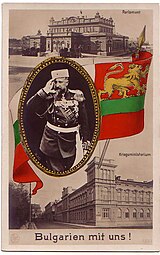Bulgaria during World War I


The Kingdom of Bulgaria participated in World War I on the side of the Central Powers from 14 October 1915, when the country declared war on Serbia, until 30 September 1918, when the Armistice of Salonica came into effect.
After the
When the First World War started in July 1914, Bulgaria, still recovering from the economic and demographic damage of the
Although the smallest of the Central Powers, Bulgaria made vital contributions to their common war effort. Its entry heralded the defeat of Serbia, thwarted the goals of Romania,[2] and catalyzed the Ottoman war effort by providing a land and rail link from Germany to Istanbul, that is, on Via Militaris.[3]
Though the Balkan theatre saw successful campaigns of rapid movement by the Central Powers in 1915 and 1916, the conflict degraded into
The 1919
Background
The Balkan Wars

When Bulgaria proclaimed its independence from the
To achieve its goals, the Bulgarian government, under
The opening stages of the
The formal ending of the war was marked by the signing of the
The treaty failed to make clear provisions for the division of the former Ottoman territories between the victors, which brought about the dissolution of the
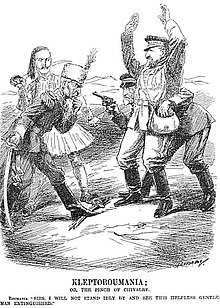
The eruption of this Second Balkan War tore a rift in the relations between Bulgaria and Russia and led to the downfall of the Danev government amidst the news of Bulgarian defeats in the field. A new liberal coalition government under Vasil Radoslavov took control and immediately began seeking a diplomatic solution to the crisis, looking primarily towards Germany and Austria-Hungary for help.[16] Direct negotiations with Serbia and Greece proved inconclusive, but following Bulgaria's offer to cede Southern Dobruja to Romania, both sides agreed to begin peace talks in Bucharest. At the same time, the Bulgarian army managed to stabilize the Serbian and Greek fronts and even go on the offensive. Bulgarian forces threatened to encircle the Greek army completely, but with the Romanians only a few kilometers from the Bulgarian capital of Sofia and the Ottomans in good position to invade the whole of southeastern Bulgaria, the warring countries concluded an armistice in July 1913.[17]
Following the cessation of hostilities, the peace talks in Bucharest resumed. The Bulgarian delegation found itself in almost complete isolation, with only the partial support of Russia and Austria-Hungary, which forced it to accept the coercive conditions of its opponents and sign the Treaty of Bucharest of 1913.[18] The treaty required Bulgaria to cede Southern Dobruja, most of Macedonia (including the "uncontested zone" that had previously been bestowed to it by the 1912 treaty between Bulgaria and Serbia) and the town of Kavala.
The peace treaty with the Ottomans had to be dealt with on a bilateral basis. Initially, the Bulgarian diplomacy maintained the position that the question about the possession of
Bulgaria in the aftermath of the Balkan Wars

The outcome of the
The Radoslavov government faced the uneasy task of integrating the new population and the acquired territories that were not ceded back, as well as rebuilding the economy and the military potential of the country.Internal bickering within the People's Liberal Party (one of the three governing coalition parties) and the lack of a majority in parliament forced the dissolution of the legislative body. General elections were called for the pre-war borders of Bulgaria in November 1913 and held for the first time under nationwide proportional representation. The government parties gained only 97 seats as compared to the 107 seats of their opponents, which prompted a new resignation of the government in December.[21] Tsar Ferdinand held consultations with several important politicians, but once again preferred to appoint a government with Radoslavov as prime minister and dissolve the newly elected parliament. When the next elections were held in March 1914, the population of the new territories was allowed to participate even though many participants had not yet received Bulgarian citizenship. During the campaign, the spokesmen of the opposition parties were practically prevented from campaigning in these lands on the grounds of the alleged threat to their safety. Ottoman officials, however, were allowed to visit the local Muslim populations and urge them to vote for the government. Despite these and other extreme measures, the liberal parties gained 116 seats, as many as their opponents, and their numbers were increased by another 16 following the completion of the verification process.[21] The government was finally able to focus its attention on more pressing internal and external matters. Radoslavov, however, remained handicapped by this fragile majority and was often forced to compromise with his coalition partners, falsify election results or simply neglect parliament.
Economic situation
Bulgarian participation in the Balkan Wars disrupted the expansion of the Bulgarian economy and proved crippling for public finances, with the financial cost of the war against the Ottoman Empire alone at over 1.3 billion
Agriculture, which was the leading sector of the economy, was badly affected, and overall production was reduced by about 9% compared to 1911. Still, the country avoided a large food crisis.[23] Thousands of peasant workers engaged in agricultural activities became casualties during the wars. The number of available horses, sheep, cattle and livestock was between 20% and 40% lower. The single most damaging event was the loss of Southern Dobruja: it had accounted for 20% of Bulgarian grain production before the wars and contained the largest and most developed Bulgarian farming communities.[24] This, combined with bad weather, held the harvest of all crops to 79% of the pre-war level in 1914.[24]
Unlike the agriculture sector, Bulgarian industry was less affected, even though problems occurred due to its complete dependence on foreign imports of machinery and spare parts. Production registered a modest decline and was able to maintain a constant level of capital investment that led to recovery of the sector as early as 1914.[23]
External trade fell drastically in 1913, with exports reduced by 40% and imports by 11%. This led to a soaring trade deficit of over 87 million
Foreign policy
Dealing with the international isolation that had befallen Bulgaria was a major priority of the Radoslavov government. This included re-establishing diplomatic relations with Bulgaria's neighbors, first with the Ottoman Empire in September 1913, then with Serbia in December of the same year and Greece in March 1914. Nevertheless, relations with the Balkan states remained strained due to their fear of Bulgarian
The most active Entente power in the Balkans was Russia, which sought to limit Austro-Hungarian influence in the area by creating a new Balkan League that was to include Serbia, Montenegro and possibly Romania and Bulgaria. The latter was not in the center of these plans. Though its participation was viewed as attractive enough, Russian diplomacy spent much more time and effort courting Romania, which achieved little practical results, but stirred negative emotions and further alienated Bulgaria.
France and the United Kingdom were willing to let Russia deal with Bulgaria and preferred not to intervene directly.
The most important task that faced the Radoslavov government in its foreign policy following the Treaty of Bucharest was to secure a loan that could provide the funds needed to pay the financial cost of the Balkan Wars, develop the new territories and continue paying a government debt of over 700 million golden leva.[32][33] The difficult task was entrusted to Foreign Minister Nikola Genadiev and Finance Minister Dimitar Tonchev, who were first dispatched to France, which held a considerable chunk of the Bulgarian public debt and from which Bulgaria had usually obtained loans before the Balkan Wars. The French refused to extend more loans, due to Russian pressure, despite the fact that the Bulgarian representatives were ready to accept certain unfavorable conditions and that French banks were simultaneously granting loans to Serbia, Greece, Romania and the Ottoman Empire.[32][33] In October 1913, Tonchev managed to secure a short-term loan of 30 million leva from Austrian banks, but the sum was far from sufficient. In February 1914, the Bulgarians again turned to France and were met with unacceptable conditions.
Tonchev, assisted by the German and Austro-Hungarian representatives in Sofia, Gustav Michahelles (
In July 1914, a consortium of German banks led by the Disconto-Gesellschaft granted a 500 million golden leva loan to Bulgaria under harsh conditions. The sum would be received in two installments of 250 million each and had to be repaid within 50 years with an annual interest of 5%. The Bulgarians were obliged to grant the German consortium the contract for the construction of a new port in Porto Lagos and a railway leading to it; the Germans were also to take over the running of the state mines in Pernik and Bobov Dol.[32] The government managed to pass the loan through a vote in parliament despite furious opposition. The debate took place among numerous fist fights. The prime minister was seen to wave a revolver above his head. The government claimed the loan had been approved by show of hands.[21]
The loan agreement was a heavy defeat for Russian and French diplomacy, whose attention was also diverted by the July Crisis surrounding the assassination of the Archduke Franz Ferdinand of Austria. At this point, it did not yield a firm commitment by Tsar Ferdinand and Bulgaria to the cause of the Central Powers.[32]
Bulgaria at the beginning of the First World War
On 28 June 1914,
Neutrality
Immediately following the outbreak of hostilities, the Bulgarian tsar and prime minister decided to declare a policy of "strict and loyal" neutrality, a stance that was popular with both ruling and opposition parties.[21] Radoslavov also realized that the lack of proper diplomatic preparation and support from some of the Great Powers had been a major cause for the Bulgarian defeat in 1913, and he intended not to repeat the same mistakes. In order to adjust to the new reality of war, the government managed to pass a bill for the declaration of martial law and a bill for an internal loan of 50 million leva for the needs of the army.
The news of Bulgarian neutrality was received well in Entente capitals, even if their approach towards the country differed. Initially, these powers thought the war would be short. Bulgaria was not given an important role in their plans, as its diplomatic isolation was viewed as weakness. Romania, with its large population, substantial oil reserves and strategic position on the flank of Austria-Hungary, was reckoned a more attractive ally.[37] This was especially the case in France, whose ambassador in Bucharest was heavily engaged in fighting German and Austrian influence in the country. Great Britain also hoped that a Romanian entry into the war on its side would force Bulgaria and even the Ottoman Empire to at least remain neutral, while Greece might brave itself to support Serbia openly. The mood in Saint Petersburg was far less optimistic, as the Russians were aware that the price tag of Romania's entry into the war would include Bessarabia and also feared that its intervention would only extend the already huge Eastern Front.[37]
The initial reaction of the Central Powers to the declaration of neutrality was similar to that of the Entente. Germany and Austria-Hungary in particular were weighing the possibility of encouraging immediate Bulgarian intervention against Serbia, because the neutrality of Italy and Romania, countries that had been their allies prior to the outbreak of the war, was a major defeat for German and Austrian diplomacy. Radoslavov, who was generally pro-German, engaged in talks with the German and Austro-Hungarian ambassadors as early as July 1914, but in the end he preferred to reaffirm Bulgaria's neutrality. On other diplomatic fronts, the prime minister achieved greater results with the signing of a secret treaty between Bulgaria and the Ottoman Empire on 6 August 1914.[38] This was a mutual defense pact that would come into effect if either party was attacked by another Balkan power. Both countries pledged not to attack other Balkan countries without consultation with each other. In the absence of such consultation, the parties pledged benevolent neutrality in such a conflict. Bulgaria additionally agreed to notify the Ottoman Empire of any impending military mobilization. The treaty was kept in deep secrecy, and it remained unknown to most other powers; Germany was made aware of its existence in December 1914.[38] When the Ottomans entered the war on the side of the Central Powers in October 1914, Bulgaria reaffirmed its neutrality.
Foreign diplomatic activity in Bulgaria
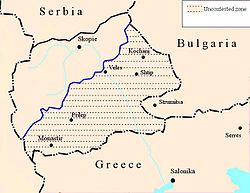
German and Austro-Hungarian diplomats began probing the Bulgarian government's intentions immediately following the initial declaration of neutrality. The two countries presented Tsar Ferdinand with a draft of a military agreement between the Central Powers and Bulgaria.
Entente diplomats did not sit idly by either. Russia was still trying to build a new Balkan League that would include Serbia, Montenegro, and Bulgaria. Thus Serbia preferred to face Austria-Hungary on their own, with benevolent Bulgarian neutrality for which they offered to cede about a quarter of the uncontested zone, while keeping total control of the Vardar. This however did not deter Sazonov from ordering Savinsky to offer vague territorial acquisitions to Ferdinand and Radoslavov in exchange for Bulgaria's cooperation.
The Russians were also restrained in their activity by their allies, especially France, which preferred the cooperation of Romania rather than Bulgaria. Fresh diplomatic initiatives from France were expected following the appointment on 26 August 1914 of Théophile Delcassé, a diplomat with extensive experience regarding Balkan matters, as French foreign minister. French diplomacy, like Russian diplomacy, also toyed with the idea of a new Balkan League directed against the Ottoman and believed that Bulgaria could be offered Eastern Thrace up to the Midia-Enos line.[42] Still, France's prestige and influence were greatly reduced in Bulgaria, due to its behavior during the Balkan Wars. This forced the French to admit the leading role of Russia in all attempts of gaining Bulgarian support and limit themselves to cautious support of Russian proposals.
The British government thought it best to avoid any complications in the Balkans, feeling that a Balkan alliance of neutral countries was better suited to its interests This conflicted with Russian ideas of getting Bulgarian military support in exchange for territorial concessions by it neighbors.
In October 1914, the Ottoman Empire entered the war on the side of the Central Powers, which considerably altered the political and military situation in the Balkans. Radoslavov realized that Bulgaria's value as a potential ally had now increased substantially. The new situation also increased the bargaining power of Germany and Austria-Hungary in the remaining neutral Balkan capitals, but it did not enhance the Entente's cause in its negotiations with Bulgaria.[46] All the Allies could do was send a note to Radoslavov promising unspecified territorial gains in exchange for strict neutrality and further gains if Bulgaria joined the Entente in the war.[47] The Bulgarian prime minister could not accept such a vague offer in the face of Serbia's continued determination not to cede lands to Bulgaria. On 9 December, the Allies, who realized their previous mistake, sent a new declaration promising Bulgaria Ottoman Eastern Thrace up to the Midia-Enos line and "fair" territorial gains in Macedonia in exchange for its neutrality.[48][49] Radoslavov again refused to make any commitments and confirmed his intention to keep Bulgaria on the already established course.
The End of Neutrality
As 1914 came to an end, Bulgaria remained on the sidelines of World War I. Popular opinion lacked enthusiasm for entering the conflict and supported the country's stance of neutrality. At this point, Prime Minister Radoslavov adopted a "wait and see" policy while at the same time he successfully probed the abilities of the warring alliances to satisfy Bulgarian territorial ambitions. A final commitment could be made only when one of the sides had gained a decisive military advantage and had firmly guaranteed the fulfillment of Bulgarian national ideals.
On the battlefields far from Bulgaria, the war had entered a long period of stalemate with no side appearing to gain the upper hand. On the Western Front in February 1915, the French failed to break the German lines at the First Battle of Champagne, while further attempts at the Second Battle of Artois during May also came to an unsuccessful conclusion.[50] The Germans had decided to focus their efforts on the Eastern Front, where they had considerable success against the Russians in the Second Battle of the Masurian Lakes in February 1915, but their gains were largely negated at the Siege of Przemyśl in March.[50] The Germans and Austrians then undertook new counterattacks to restore their positions. Finally, in May 1915, Italy entered the war on the side of the Entente. Under these circumstances, the military and political value of the neutral Balkan countries increased significantly.
The military successes of each warring side were often a major asset in their diplomatic courtship of Bulgaria. Thus when Przemyśl fell and the Anglo-French landed in the
At the same time, Germany hoped in vain to use the payment of a 150 million installment of the 1914 loan as means of exerting influence on the Bulgarian government, and Radoslavov turned his attention in an unexpected direction by sending Genadiev to
On 29 May, not long after Italy's entry into the war, the Allied representatives in Sofia independently presented an
The Central Powers were aware of the Allied overtures to Bulgaria and only a few days before the Allied proposal of 29 May came up with an offer of their own. The Austrian and Germans would guarantee both the contested and uncontested zones of Macedonia in exchange for Bulgarian neutrality and if a war with Greece and Romania resulted, then Bulgaria could expect the lands that it had lost in 1913.[56] Tsar Ferdinand issued a speedy reply, but at this point he too preferred not to commit the country to the war.
The Allies struggled to give a unified reply to Radoslavov's questions as their positions began to diverge. Britain's foreign minister
"The Bulgarian Summer" of 1915
The summer months of 1915 saw a decisive clash between the diplomacy of the Entente and the Central Powers. Marcel Dunan, a young French historian, reporter for the French press and witness of the critical events, summarized the importance of this period for the entire course of the war by simply naming it the "Bulgarian Summer" of 1915.[59] Bulgaria's strategic geographic position and strong army now, more than ever, could provide a decisive advantage to the side that managed to win its support. For the Allies, Bulgaria could provide needed support to Serbia, shore up Russia's defenses, and effectively neutralize the Ottoman Empire, while it could ensure the defeat of Serbia for the Central Powers, cut off Russia from its allies and open the way to Constantinople, thus securing the continuous Ottoman war effort.[60] Both sides had promised more or less the fulfillment of Bulgaria's national aspirations, and the only problem facing the Bulgarian prime minister was how to secure maximum gains in exchange for minimum commitments.
During this time, many Entente and Central Powers dignitaries were sent to Sofia in an effort to secure Bulgaria's friendship and support. Allied representatives met with the leaders of the Bulgarian opposition parties and also provided generous financial support for opposition newspapers; they even attempted to bribe high-ranking government officials.
Still, it took Entente diplomacy more than a month to give an answer to Radoslavov's questions and the reply proved far from satisfactory. In reality, it hardly differed from the offer the Allies presented in May. Once again the promises lacked a clear guarantee that Serbia would cede the desired lands and there was not even a mention of Southern Dobruja. In the eyes of the Bulgarians, this was a manifestation of Entente helplessness in the face of the conflicting ambitions of its smaller Balkan allies. The diplomatic positions of the Central Powers in Sofia were strengthened immensely, forcing the Bulgarian tsar and prime minister to assume a course towards a final alignment of the country to the side of the Central Powers. In August, a Bulgarian military mission led by Colonel Petar Ganchev, a former military attaché in Berlin, was dispatched to Germany to work out the details for a military convention.
Throughout the month of August, the Allied diplomatic activity grew more incoherent. British and French diplomats began to realize that in the face of the stubborn Serbian and Greek refusals of any immediate concessions that the best they could hope for was to keep Bulgaria neutral. In the face of its diplomatic failure, the Entente even resorted to more unusual means of keeping Bulgaria on the sidelines. The Allies and their Bulgarian political sympathizers attempted to buy out the country's grain harvest and create a food crisis. This affair was revealed to the Bulgarian government, and the perpetrators were arrested. Entente diplomats continued to pressure the Serbian government, finally forcing it to assume a more yielding attitude. On 1 September 1915, the Serbian prime minister agreed to cede about half of the uncontested zone, but he demanded that Serbia should keep most of the land to the west of the Vardar, including the towns of
Bulgaria enters the war
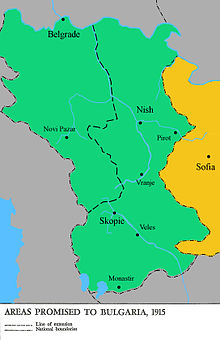
On 6 September 1915, Bulgaria formalized its affiliation with the Central Powers by concluding three separate documents of political and military character. The first document was signed by Prime Minister Radoslavov and the German ambassador Michahelles in Sofia: the Treaty of Amity and Alliance between the Kingdom of Bulgaria and the German Empire. It consisted of five articles that were to remain in force for five years. According to the treaty, each of the contracting sides agreed not to enter an alliance or agreement directed against the other. Germany was obliged to protect Bulgarian political independence and territorial integrity against all attack that could result without provocation on the side of the Bulgarian government. In exchange, Bulgaria was obligated to take action against any of its neighboring states if they attacked Germany.[67]
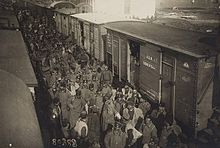
The second important document was a secret annex to the Treaty of Alliance. It specified the territorial acquisitions that Germany guaranteed to Bulgaria: the whole of Vardar Macedonia, including the so-called contested and uncontested zones, plus the part of Old Serbia to the east of the Morava river.[67] In case Romania or Greece attacked Bulgaria or its allies without provocation, Germany would agree to Bulgarian annexation of the lands lost to these countries by the Treaty of Bucharest of 1913, and to a rectification of the Bulgarian-Romanian border as delimited by the Treaty of Berlin of 1878. In addition, Germany and Austria-Hungary guaranteed the Bulgarian government a war loan of 200,000,000 francs and in case the war lasted longer than four months, they guaranteed an additional supplementary loan.[67]
The third document was concluded at the German Eastern military headquarters in
On the same day, Bulgaria and the Ottoman Empire concluded
The Allies were unaware of the treaty between Bulgaria and Germany and on September 13 made a new attempt to gain Bulgarian support by offering the occupation of the uncontested zone by Allied troops as a guarantee that Bulgaria would receive it after it had attacked the Ottoman Empire.[70] This offer, however, was a sign of desperation and even the British foreign minister considered it inadequate.[70] Radoslavov decided to play along and asked for further clarification.
On September 22, Bulgaria declared general mobilization and Radoslavov stated that country would assume a state of "armed neutrality" that its neighbors should not perceive as a threat.
On 14 October, Bulgaria declared war on Serbia and the Bulgarian Army invaded Serbian territory. British Prime Minister H. H. Asquith concluded that "one of the most important chapters in the history of diplomacy" had ended.[72] He blamed this heavy Allied diplomatic defeat on Russia and most of all on Serbia and its "obstinacy and cupidity". In military terms, Bulgaria's involvement also made the position of the Allies in Gallipoli untenable.
The Bulgarian Army
Organization and state of the army
The demobilization of the

In peacetime, the Bulgarian Land Forces consisted of three armies, ten infantry divisions, forty infantry regiments, nineteen artillery regiments, eleven cavalry regiments, five battalions of engineers, one railway battalion, one telegraph battalion and one technical battalion.[74] These forces retained the territorial organization established prior to the First Balkan War. The country was divided in three army inspectorates, ten Division districts and forty Regiment districts. During wartime, the staff of each of these administrative units formed the headquarters and staff of a separate army, division and regiment. All male Bulgarian subjects were eligible to serve in the army when they reached the age of 20. At that age, they were conscripted for a period of two years in the infantry and three years in other branches of the Active (Standing) Army. Following this period, a person was enrolled for another 18 years in the infantry or 16 years in other branches of the Active Army Reserve. This Reserve was the heart of the army, as it encompassed the bulk of the available manpower and reached a size of 374,613 men by the end of 1914.[75] Finally, the men between 40 and 48 years served in the National Militia (Narodno Opalchenie) which was divided in two "Ban's". Initially, the First Ban was composed of men 41 to 44 years old and the Second Ban was composed of men 45 to 48 old. Around 1914, due to the experience of the Balkan Wars, the men between 45 and 46 years old that belonged to the Second Ban were formed into separate Etappe Troops. By early 1915, the Bulgarian Army could rely altogether on some 577,625 trained men aged 20 to 48.[75] A special inquiry also determined that another 231,572 men were eligible for military service but had not received their training. Many of those were called up and received training in 1915. The principal
The Bulgarian
| Weapon system | Quantity | Ammunition stock | Ammunition per single weapon |
|---|---|---|---|
Mannlicher rifles
|
251,713 | 150,810,600 | 600 |
Mannlicher carbines
|
9,513 | 1,781,800 | 187 |
| Mosin–Nagant rifles | 46,056 | 42,750,000 | 928 |
| Berdan rifles | 54,912 | 27,757,340 | 500 |
| Mauser rifles | 12,918 | 11,188,000 | 860 |
| Martini–Henry rifles | 3,614 | 900,000 | 250 |
| Captured Serbian rifles | 995 | 86,000 | 86 |
| Krnka rifles | 12,800 | 1,224,000 | 95 |
Parabellum 1908 pistols
|
3,957 | 273,000 | 69 |
| Smith & Wesson revolvers | 1,112 | 105,320 | 94 |
Maxim machine guns
|
248 | 10,667,763 | 43,000 |
| Sabres | 19,000 | - | - |
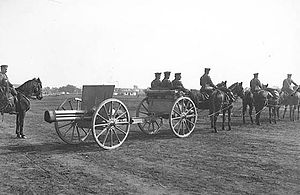
The artillery consisted of various field, mountain and fortress guns, most of it produced by the two world-leading manufacturers Schneider and Krupp. During the Second Balkan War, the Bulgarian army had lost a sizable quantity of its artillery, but by 1915 the country managed to recover its losses and even increase the number of available guns, so that by October 1915, the artillery park consisted of 1,211 pieces, of which 418 were not quick-firing guns.[78] The ammunition for the artillery was however in short supply, and the lack of any large home-based manufacturing capability left the army with only about 500 shells per gun, enough to satisfy the artillery's needs for about two months.
Bulgaria possessed a small naval force of
The Bulgarian air force had gained some experience during the First Balkan War, but its development was halted following the defeat in the Second Balkan War. The airplane and balloon sections were reduced to two companies and made part of a technical battalion that was attached to the army's engineers. The airplane section, which included 5 functional aircraft and 124 men (including 8 pilots), was stationed on an airfield outside of Sofia. Despite the difficult conditions, the command took measures to improve the material and personnel situation of the air troops by building a special repair workshop and opening a specialized school for the training of pilots, observers and technicians.[80] Bulgaria's hostile neighbors practically isolated it from the big airplane manufacturers and prevented it from receiving new aircraft. Under these circumstances, an alternative had to be provided by a few Bulgarian air enthusiasts who attempted to build a fully functional Bulgarian airplane. In the summer of 1915, Assen Jordanoff was the first to succeed in this task by designing and building the first Bulgarian-made airplane, which was later named Diplane Yordanov-1.[80] Still, in September 1915, the airplane section had only two German-made Albatros B.I, two French-made Blériot IX-2 and one Blériot IX-bis. They were however joined by three German Fokker-Е80Е-III and their German crew, whose task was to defend Sofia from any attacks. It was only after Bulgaria entered the war that the air force was able to receive new aircraft.[81]
1915 also saw the birth of the anti-aircraft component of the Bulgarian armed forces. The first such specialized formation was a mixed battery of six guns (2 quick-firing 75 mm Krupp guns and 4 not quick-firing 87 mm Krupp guns), seven machine guns (five Madsen and two Hotchkiss), which was deployed around Sofia.[81]
Mobilization
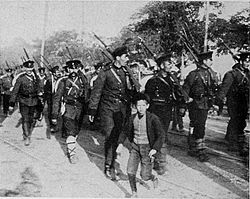
The decree for general mobilization of the Bulgarian Army was issued by the Bulgarian government on 22 September 1915, but as this happened late in the evening, the orders reached the local authorities only on the next day. Around this time the total surface area of the kingdom was 114,424 square kilometers and its population stood at 4,930,151 people, out of whom 2,484,122 were males.[82]
The mobilization was carried out behind the established schedule because the nature of Colonel Ganchev's mission to Germany was held in great secrecy to the last moment, even from the Bulgarian General Staff, which was left out of the negotiations completely. The whole mobilization period, which lasted for 17 or 18 days, was accompanied with some difficulties of material character due to the insufficient quantities of uniforms, horses and carts. Even though there was no serious manpower shortage, the absence of the enthusiasm demonstrated during the mobilization prior the First Balkan War was visible. By the beginning of October, the total number of mobilized personnel reached 616,680 men,[83] which represented over 12 percent of the population and almost a quarter of the male inhabitants of the country. Instead of the five divisions required by the military convention, Bulgaria mobilized 11 infantry and one cavalry division as well as numerous auxiliary and militia units. Most of these forces were deployed in three field armies, two of which concentrated on the Serbian border and one on the Romanian border.[84][85]
The Bulgarian constitution designated the monarch as commander-in-chief of the Bulgarian armed forces in time of peace and in time war. In practice, however, the Bulgarian tsar could delegate this function in wartime by granting all the powers of the commander-in-chief to a different person.[86] During the First Balkan War, Tsar Ferdinand had remained acting supreme commander, but his lack of military education and experience forced him to rely heavily on his assistant commander-in-chief Lieutenant General Mihail Savov.
The experience of the Balkan Wars convinced the tsar in 1915 to delegate the title and its powers entirely to a different person. Out of the few appropriate candidates that were available, Ferdinand chose the pro-German Minister of War Major General Nikola Zhekov. The powers of the commander-in-chief were not regulated by law and even from the beginning, this caused some friction with the government. In his new role, General Zhekov exercised direct control over all forces except those that remained in the interior of the country, which were placed under the command of the new Minister of War Major General Kalin Naydenov.[87] At the same time, Major General Konstantin Zhostov succeeded Lieutenant General Kliment Boyadzhiev, who was appointed commander of the 1st Army as Chief of the Bulgarian General Staff.
The military convention between Bulgaria and the Central Powers laid down the general plan for its
Bulgaria at war
Military operations
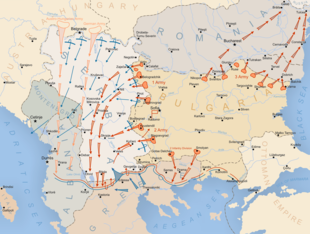
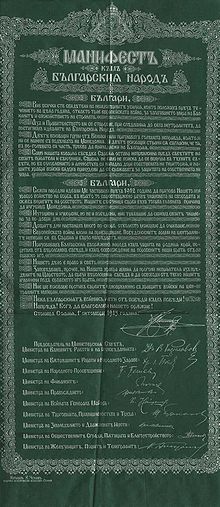
Conquest of Serbia
The general mobilization of the
Allied inactivity allowed the Central Powers to continue their preparations for the offensive undisturbed. By early October, however, the Austro-Hungarians were unable to furnish the required minimum of 6 divisions for the attack, so the Germans had to step in with additional forces. The forces, under the overall command of Field Marshal Mackensen, were deployed in the German 11th Army, with 7 German divisions led by General Max von Gallwitz, and the Austro-Hungarian 3rd Army, with 4 Austro-Hungarian and 3 German divisions led by General Hermann Kövess von Kövessháza. On 6 October 1915, Mackensen opened the offensive, as scheduled, with a powerful artillery barrage along the Sava–Danube front and on the next day, the main body of his forces crossed the rivers.
According to the convention, Bulgaria was obliged to move against Serbia within five days of the German and Austro-Hungarian attack, but owing to a delay in the concentration of some of the forces needed, the schedule could not be kept. The Serbians were surprised by Bulgarian inactivity and were forced to begin shifting part of their forces from the Bulgarian border to face the Germans and Austro-Hungarians to the north, which eventually allowed their eastern neighbors to finish their preparations undisturbed. The Bulgarians deployed two
On 14 October, with most of the preparations completed, Bulgaria finally declared war on Serbia and officially entered the First World War. Around this time, the Germans and Austro-Hungarians had penetrated into Serbia on a front that was 140 kilometers in length and 15 kilometers in depth. In order to close the 90-kilometer gap between the flanks of the German 11th Army and the Bulgarian 1st Army, Mackensen ordered the latter to invade the valley of the river Morava and take Niš and Aleksinac. In accordance with this order, the Bulgarians attacked along the entire front of their 1st Army, quickly driving out the Serbian units and taking control of the border area.
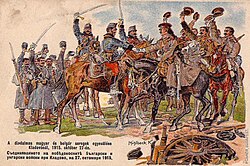
Following this easy success, the speed of the advance was much reduced due to the bad weather, which turned roads into mud, and a dense fog that sometimes limited visibility to 50 meters. In addition, the stiffening Serbian resistance and the mountainous character of the area caused the flanks of the 1st Army to halt before the fortresses of Pirot and Zaječar that were only 15 kilometers from the border. A breakthrough in the centre of the front forced the Serbians to retreat, and the two towns were occupied on 26 October.[93]
Despite its smaller size, the Bulgarian 2nd Army achieved much greater success and completed its first objective as early as 16 October by taking the town of
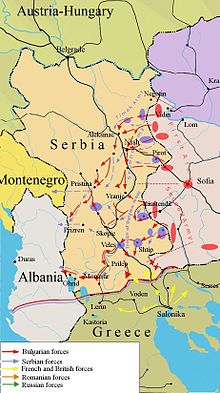
The exploits of the Bulgarian 2nd Army in Macedonia convinced the Serbians that the danger of complete encirclement was high and forced them to begin withdrawing their forces to
The Serbian Army was now retreating and concentrating on the Kosovo plain, where they hoped to make a stand and buy time either to breakthrough and join the Allies in Macedonia or escape an encirclement. Under these circumstances, the Bulgarian High Command and the headquarters of Army Group Mackensen agreed to pursue the retreating Serbians relentlessly, to cut their possible retreat routes and to undertake a decisive advance towards
In November, while the decisive Serbian defeat unfolded, the French attempted to exert pressure on the Bulgarian 2nd Army, but were soon forced to halt their attempts to drive north. The forces of General
By the middle of December, the entire Kingdom of Serbia was occupied by the armies of the Central Powers and the Allies were pushed back to Salonika by the Bulgarians. Within two months of its entry into the war, Bulgaria achieved its main war goal: the conquest of Vardar Macedonia. For the duration of military operations against Serbia and the Entente in 1915, the Bulgarian Army committed a total of around 424,375 men,[102] while its casualties were held to around 37,000 men.[103]
By the end of 1915, the Central Powers had established firm and unbroken control over a vast territory that stretched from the North Sea to Mesopotamia. They also drew great political and military dividends from the defeat and occupation of Serbia. Bulgaria conquered almost all the territory it desired, Germany gained unrestricted access to the natural resources of Ottoman Asia, the Ottomans received much needed German matériel assistance and Austria-Hungary secured its southern flank and could completely focus its attention on the Russian and Italian fronts.[99]
Bulgarian war crimes in Serbia
Since November 1915, when Serbia was occupied, the Bulgarian army launched crimes against the civilian population. The use of the Serbian language was banned and books in the Serbian language were burned in Niš and Leskovac. Bulgarian soldiers publicly executed those that declared themselves Serbian, the worst example being the Surdulica massacre, where an estimated 2,000–3,000 Serbian men were executed in two years. Bulgarian atrocities purportedly sparked the Toplica Uprising in 1917. Bulgarian forces swiftly suppressed the insurrection, killing over 20,000 civilians and guerrillas in retribution. Bulgarians have deflected blame for these atrocities onto the Austro-Hungarians, though reliable sources confirm their culpability. Following the Allied breakthrough on the Macedonian front, Serbia pressed for an invasion of Bulgaria; this proposal was blocked by the British who feared the Serbs would take revenge on the Bulgarian population.[104][105]

Establishment and development of the Macedonian front during 1916
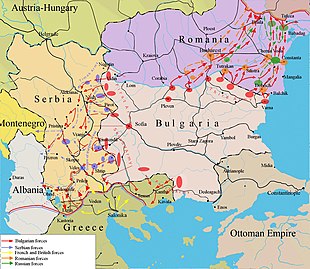
The Romanian campaign
1917 – Stalemate on the Macedonian front
1918 – End of the War

In September 1918 the French, British, Italians, Serbs and Greeks broke through on the
Images
-
The territories ceded toTreaty of Neuilly, 1920.
-
the nationalities in Northern Dobruja at the beginning of the 20th century.
-
The Dobruja after 1878.
-
Western Thrace within Greece.
See also
- 1910s in Bulgaria
- Bulgarian irredentism
- Diplomatic history of World War I#Bulgaria
- Romania in World War I
- Serbia in World War I
- Greece during World War I
- Western Rumelia
- Eastern Rumelia
- Macedonia (region)
- Invasion of Serbia by Bulgaria during the First World War
In literature
The story ¨Kradetzat na praskovi¨ (English: "The Peach Thief") depicts the love story between a Bulgarian colonel's wife and a Serbian prisoner of war. The First World War is so far best presented in that story by the late Emiliyan Stanev, one of the greatest Bulgarian writers.
Notes
- ^ Bulgarian infantry divisions were significantly larger than their German and Austrian counterparts.
References
- ^ a b Tucker (1996), p. 151.
- ^ (Erickson 2001, pp. 20)
- ^ (Erickson 2001, pp. 91)
- ^ Crampton, pg.139
- ^ Crampton, pg.143
- ^ Crampton, pg.132
- ^ Hall, The Balkan Wars... pg.132
- ^ Hall, The Balkan Wars... pp.43,66–67
- ^ Crampton, pg.133
- ^ Hall, The Balkan Wars... pp.97
- ^ Crampton, pg.134
- ^ Hall, The Balkan Wars... pp.111
- ^ Hall, The Balkan Wars... pp.102
- ^ a b Stavrinos pg.539
- ^ Hall, The Balkan Wars... pp.117–119
- ^ Hall, The Balkan Wars... pp.118–119
- ^ Hall, The Balkan Wars... pp.120–122
- ^ Hall, The Balkan Wars... pp.123–125
- ^ Hall, The Balkan Wars... pp.125–126
- ^ Michael Robert Marrus. The unwanted: European refugees from the First World War through the Cold War. Temple University Press, 2002, pg. 46.
- ^ ISBN 978-0-19-820514-2– via Google Books.
- ^ Hall, The Balkan Wars... pp.138
- ^ a b c "Българското стопанство в годините на войните /1912 1918 г./" [The Bulgarian Economy during the War Years 1912–1918] (in Bulgarian). Archived from the original on 27 March 2016.
- ^ a b Lampre, pp.42–43
- ^ Панайотов, pg.355
- ^ Ганчев p. 369
- ^ Илчев, pp.37-38
- ^ Илчев, pp.37–38
- ^ Hamilton, pp.401
- ^ Илчев, pp.44
- ^ Илчев, pp.45
- ^ a b c d Crampton, A concise history of Bulgaria pg.137
- ^ a b Илчев, pp.46
- ^ Илчев, pp.52
- ^ Willmott 2003, p. 26
- ^ Willmott 2003, p. 27
- ^ a b c d Илчев, pp.64
- ^ a b (Erickson 2001, pp. 31)
- ^ Lalkov, Балканската политика на Австро-Унгария, 1983. Sofia pp.175
- ^ Дерменджиева, pp.235
- ^ Илчев, pg,71–72
- ^ Илчев, pg,76
- ^ Илчев, pg,79
- ^ Roberts, pg,222
- ^ Roberts, pg,223
- ^ Илчев, pg,94
- ^ Дерменджиева, pp.237
- ^ Roberts, pg,225
- ^ Илчев, pg,103
- ^ a b Ганчев, pg,362
- ^ Hamilton, pp.398
- ^ Илчев, pg,125
- ^ Илчев, pg,127
- ^ a b Илчев, pg,146
- ^ Илчев, pg,147
- ^ a b c Roberts, pg,230
- ^ Roberts, pg,231
- ^ Илчев, pp,185–186
- ^ Dunan, Marcel (April 12, 1917). "L'été bulgare, notes d'un témoin- juil-let-Octobre 1915". Paris, Chapelot – via Internet Archive.
- ^ Yokell, pg,61
- ^ Илчев, pg.194
- ^ a b Roberts, pg,233
- ^ a b Илчев, pg.210
- ^ a b Yokell, pg,87
- ^ a b Илчев, pg.205
- ^ Yokell, pg,82
- ^ a b c Yokell, pp 102–103
- ^ a b c d Lutz, pp 745–746
- ^ Ганчев, pг,364
- ^ a b c Илчев, pg. 207
- ^ Roberts, pg 237
- ^ Roberts, pg,238
- ^ a b Крапчански, pp,94–95
- ^ Крапчански, pg,104
- ^ a b c Крапчански, pg 108
- ^ Крапчански, pg 202
- ^ "Between two wars 1913-1915". Bulgarian Artillery.
- ^ Крапчански, pg 109
- ^ a b Prokopiev, pg,109
- ^ a b Nedyalkov, pg,40
- ^ a b Nedyalkov, pg,41
- ^ Ганчев, p.370
- ^ Крапчански p. 112
- ^ Нойков p. 48
- ^ Ганчев, pp,374–375
- ^ Нойков p. 31
- ^ Ганчев, pg 379
- ^ Българската армия в Световната война, vol. II , pg. 14; Държавна печатница,София 1938
- ^ Българската армия в Световната война, vol. II (1936), pg. 14
- ^ Българската армия в Световната война, vol. II (1936), pg. 904.
- ^ Hall. Balkan Breakthrough..., pp,44–45
- ^ Ганчев, pg,380
- ^ Ганчев, pg,388
- ^ Нойков p. 60
- ^ Българската армия в Световната война 1915 – 1918, Vol. III (1938), pg. 652
- ^ Ганчев, pg 390
- ^ Нойков p. 64
- ^ Нойков pp. 66–67
- ^ a b История первой мировой войны 1914–1918 гг.
- ^ Ганчев, pg 401
- ^ Hall. Balkan Breakthrough..., pg 50
- ^ Българската армия в Световната война 1915 – 1918, Vol. III (1938), pg. 1146 – During the campaign the Bulgarians reinforced their forces with three additional infantry divisions, or some 129,061 men.
- ISBN 9789545287527– via Google Books.
- ^ "Сурдулица 1915-1918 - www.zlocininadsrbima.com". www.zlocininadsrbima.com. Retrieved 2020-02-07.
- ISBN 9788670251717.
External links
- Articles relating to Bulgaria at 1914-1918-online. International Encyclopedia of the First World War.
Further reading
In English:
- Gilbert, Martin. The First World War, (2008) p. 468
- Hall, Richard C. "Bulgaria in the First World War," Historian, (Summer 2011) 73#2 pp 300–315 online
- Hall, Richard C. "'The Enemy is Behind Us': The Morale Crisis in the Bulgarian Army during the Summer of 1918," War in History, (April 2004), 11#2 pp 209–219,
- Tucker, Spencer (1996). The European powers in the First World War: an encyclopedia. Taylor & Francis. ISBN 978-0-8153-0399-2.
- Tucker, Spencer (2005). World War I: encyclopedia, Volume 1. ABC-CLIO. ISBN 978-1-85109-420-2.
- Erickson, Edward J. (2001). Ordered to Die: A History of the Ottoman Army in the First World War. ISBN 978-0-313-31516-9.
- R. J. Crampton (2005). A concise history of Bulgaria. Cambridge University Press. ISBN 978-0-521-61637-9.
- R. J. Crampton (1987). A short history of modern Bulgaria. CUP Archive. ISBN 978-0-521-27323-7.
history of bulgaria.
- Hall, Richard C. (2000). The Balkan Wars, 1912–1913: Prelude to the First World War. ISBN 978-0-415-22946-3.
- Stavrinos, Leften (2008). The Balkans since 1453. C. Hurst & Co. Publishers. ISBN 978-1-85065-551-0.
- Lampe, John (1986). The Bulgarian economy in the twentieth century. Routledge. ISBN 978-0-7099-1644-4.
- Roberts, Keith (1994). Politicians, diplomacy, and war in modern British history. Continuum International Publishing Group. ISBN 978-1-85285-111-8.
- Hamilton, Richard (2003). Origins of World War One. Cambridge University Press. ISBN 978-0-521-81735-6.
- Matthew, YOKELL (2010). SOLD TO THE HIGHEST BIDDER? AN INVESTIGATION OF THE DIPLOMACY REGARDING BULGARIA'S ENTRY INTO WORLD WAR I. Richmond University.
- Lutz. Fall of the German Empire 1914–1918, Volume I. Stanford University Press. ISBN 978-0-8047-2380-0.
- Hall, Richard (2010). Balkan Breakthrough: The Battle of Dobro Pole 1918. Indiana University Press. ISBN 978-0-253-35452-5.
- Willmott, H.P. (2003). World War I. Dorling Kindersley. OCLC 52541937.
In Bulgarian:
- В., Крапчански (1961). Кратък обзор на бойния състав, организацията, попълването и мобилизацията на българската армия от 1878 до 1944г. военно издателство, София. Archived from the original on 2007-08-12. Retrieved 2011-02-28.
- Панайотов, Филип (1999). България в 20ти век. Алманах. Труд. ISBN 978-954-528-146-4.
- Ганчев, Атанас. Войнитъ презъ Третото Българско Царство. Родна Мисълъ. Archived from the original on 2013-02-21. Retrieved 2011-02-28.
- Bulgarian Economy during the wars 1912–1918. Archived 2019-11-10 at the Wayback Machine
- Илчев, Иван (1990). България и Антантата през Първата световна война. Наука и изкуство.
- Нойков, Стефан (1922). Защо не победихме. Печатница на Армейския военно-издателския фонд, София.
- РУСИЯ И БЪЛГАРСКИЯТ НЕУТРАЛИТЕТ (1914–1915) Т. Астарджиева
- Prokopiev, Anatlii. THE AEGEAN FORMATION OF BULGARIAN NAVY IN THE FIRST WORLD WAR, ВИС кн. 1, С., 2004 г.[permanent dead link]
- Nedyalkov, Dimiter. BULGARIAN AVIATION IN THE FIRST WORLD WAR, ВИС кн. 4, С., 2005 г.
- Министерство на войната – Щаб на армията. "Българската армия в Световната война, vol. II. Войната срещу Сърбия през 1915"; Държавна печатница, София 1936
- Министерство на войната, Щаб на войската (1938). Българската армия в Световната война 1915 – 1918, Vol. III. Държавна печатница, София.
In Russian
- Корсун (1939). Балканский фронт. Воениздат НКО СССР.
- А.М. Агеев; Д.В. Вержховский; В.И. Виноградов; В.П. Глухов; et al. (1975). История первой мировой войны 1914–1918 гг. Наука.






